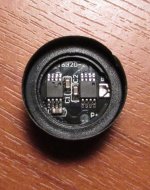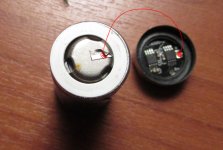One of the batteries, which worked very well for the last 5 years, failed. It works well at low levels, when the level rises to 500 mA it turns off. I took it apart - one of the microcircuits burned out. The cell itself continues to perform well without protection. The design itself is of high quality.
You are using an out of date browser. It may not display this or other websites correctly.
You should upgrade or use an alternative browser.
You should upgrade or use an alternative browser.
Olight 16340 death of the protection board
- Thread starter desert.snake
- Start date
 Help Support Candle Power Flashlight Forum
Help Support Candle Power Flashlight Forum
chillinn
Flashlight Enthusiast
Interesting, but not the first time I have heard things about Olight cells. desert.snake surely knows, but for anyone stumbling in here that may not be aware, Vapcell T8 are great.
I didn't know about Vapcell and others in this time, I bought these at the nearest electronics store, there were no others available, except for a pair of EEMB which did not suit me because of the welded terminals (then I did not know that they are easily removed with wire cutters )
)
 )
)chillinn
Flashlight Enthusiast
I did not at all intend to suggest that you made any mistake. What I had seen from others' posts about Olight cells, in particular 18650 cells, is that they barely put out any current. What is neat about the T8 is INR chemistry tolerates overdischarge, and has a high amp rating, so protection is unnecessary, thus, no protection circuit to fail. And the high capacity is nice. They're relatively new cells that seem to have appeared about 2-3 years ago in the US, but Vapcell has been around (in China) since at least 2013, maybe longer.
With modern flashlights that have built-in overdischarge protection, this works well. Old lanterns that sucked everything out of the cells are better used with protection, because they can easily kill IMR and INR, like my old SF killed 2 fresh Vapсell. It remained bright without reduction, and when it went out, the cells were already 1.2-1,5 volts and did not want to charge
JustAnOldFashionedLEDGuy
Enlightened
- Joined
- Apr 13, 2020
- Messages
- 336
As a guess, and that is all that is possible, is that the chips are used beyond their ratings, and/or there is a soldering issue causing inequal sharing of the current. Then again chips failures happen, especially when ran hot and near/over limits.
Unprotected cells can be used in newer flashlights that have good under-voltage protection, and hopefully something to protect from an internal short. Just make sure you use a good brand external charger. This would apply to a single cell. If you are using in multi-cell flashlights, get protected cells. Being able to supply high current only protects against use in a device that exceeds the cells rating. It does not protect against shorts, that can come from misuse, but also equipment failure. Stick to quality products and you won't have that issue.
Unprotected cells can be used in newer flashlights that have good under-voltage protection, and hopefully something to protect from an internal short. Just make sure you use a good brand external charger. This would apply to a single cell. If you are using in multi-cell flashlights, get protected cells. Being able to supply high current only protects against use in a device that exceeds the cells rating. It does not protect against shorts, that can come from misuse, but also equipment failure. Stick to quality products and you won't have that issue.
Last edited:
chillinn
Flashlight Enthusiast
Interesting that you blame the light. I have a few protected ICR that came as part of a trade, and I admit the protection is nice, but I don't buy them because I don't like ICR. I only buy IMR and INR, and I use them in my incans, and incan is mostly what I use. I have murdered several cells in the past, but it hasn't happened for over 2 years. I'm a lot more confident now in my judgement of SoC without checking. It's half having an idea how many minutes are on the cell, half noticing what the light level is. When a cell gets near and below 3.6V, the light level really drops, and that's easier for me to pick up on now, as opposed to before.because they can easily kill IMR and INR, like my old SF killed 2 fresh Vapсell
As a guess, and that is all that is possible, is that the chips are used beyond their ratings, and/or there is a soldering issue causing inequal sharing of the current.
This is pretty reasonable. My theory is just that Olight cells are cheap (in contrast to their lights, which seem decent enough). idk, but I would assume they source the cheapest cells they can find.
Last edited:
You use interesting language, I'm not blaming the flashlight, I'm just stating the fact that this happened. In incans, you can see when the brightness begins to fall. This is not visible in many old LED lights, the regulation is flat until the cells die completely.Interesting that you blame the light. I have a few protected ICR that came as part of a trade, and I admit the protection is nice, but I don't buy them because I don't like ICR. I only buy IMR and INR, and I use them in my incans, and incan is mostly what I use. I have murdered several cells in the past, but it hasn't happened for over 2 years. I'm a lot more confident now in my judgement of SoC without checking. It's half having an idea how many minutes are on the cell, half noticing what the light level is. When a cell gets near and below 3.6V, the light level really drops, and that's easier for me to pick up on now, as opposed to before.
This is pretty reasonable. My theory is just that Olight cells are cheap (in contrast to their lights, which seem decent enough). idk, but I would assume they source the cheapest cells they can find.
Within their specs (2.75A), they lasted 5 years with no problems, which is not like the cheapest cells.







